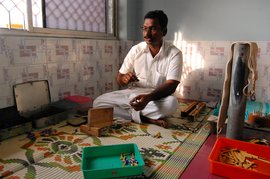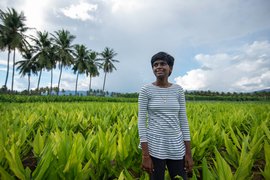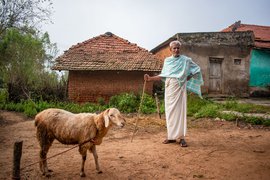They're up before the sun, and work all day, in their homes, in the field, tending to their children and the men in their families and the livestock. And they do this high in the Himalayas, up and down shingle-filled hill-paths, carrying on their backs heavy loads of produce and fodder. Meet the Pahari women of Himachal Pradesh.
Two days before Diwali, Subhadra Thakur (
in the photo below, on the right)
is colour-washing her kitchen. The walls are blue, and she slaps on white paint, with rubber-gloved hands. The counter is tidy, the cooking's been done. At 11:30 a.m., she steps outside for a short break; her grandchildren, who have come visiting, play in the sun, and she watches them with smiling, shaded eyes. In summer, she'll spend the whole day in her family's fields. But winter is coming, and with that, a little rest...


From her house in Pitangli village, to her fields, on the hillside near Mashobra (Himachal Pradesh), Subhadra and her daughter-in-law Urmil, walk down a treachorously narrow and stony path. For a kilometre and a half, it hugs hillsides, skirts valleys, cuts through a forest, and is nearly always on an incline.
The women leave early for the fields; they take with them a modest meal, and a sturdy basket to bring back in the evening the day's harvest. That's tens of kilos strapped on to their backs or on their heads at the end of a long day.


Almost all Pahari households keep some cattle. Once it was the indigenous hill-cattle that were popular – small, sure-footed, and so well-adapted to the terrain. But then exotic breeds made an appearance, and now they're everywhere – jersey cows demanding a big feed, but also producing many times more milk than the Pahari cow. Mucking out the shed, milking the cows and collecting fodder - yes, they're women's jobs too.
The hills of Himachal are achingly beautiful. But they're also achingly hard to clamber up. The local women though make it look effortless. In their bright salwar kameez and scarves, they dot the hills, hunched-up and hard-at-work, scything and bundling bales of grass and fodder for the coming winter. The grass is then sun-dried in the courtyards and stored in the open, a tall and thin 10-foot grass-hill.




The produce from the fields also feeds the family. Millets, rajma (beans) and corn are sun-dried, and some of this is pounded into flour. In the winter months, cabbage and cauliflower green the fields. But the apple trees are bare, and the last pears fall and rot in the ground.
In spring, the terraced plots –giant steps in the hill-sides – will be ploughed by Subhadra's husband, with Pahari bulls. (Her son, suffering from spondylitis, had switched to driving a tourist cab).
At the end of two crop cycles, land-owning families like Subhadra's would have made their money and stocked up for winter, when the snow can pile high on the ground and stay on for many weeks, like an uninvited house-guest. And so, the women gather, whenever they can, wood for the stoves. Even pine cones are collected from the forest paths and burnt for warmth.
In winter, much of the work moves indoors. And the women knit and cook and clean and care for the children. Rest, for the women in the hills, is a relative word. The basket they carry on their backs perhaps spends more time sitting down.




